
We’ve got a new single out today. Download the high quality MP3 for free right here
–David Child
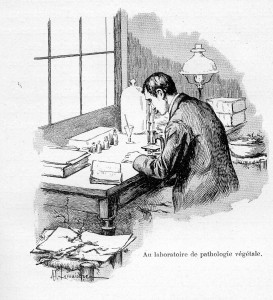
In the last blog post, I talked about how I carry around an audio recorder with me wherever I go. It’s a great way to capture melody ideas when I’m not near my main music computer. That being said, these song sketches pile up really, really quickly. If I didn’t have a system in place for organizing them, I’d have hundreds of audio files with cryptic names all over my desktop in no time. As promised, this week, I’m going to cover how I deal with this song ideas after I’ve recorded them.
As you’ve probably gleaned from this post’s title, once a week, I review all of the song ideas that have accumulated on my iPhone. I save the best ones in a catalog of song parts so that they can easily be assembled into full songs later.
Usually, I do this on my desktop computer and with an acoustic guitar within easy reach so that I can play with the ideas and come up with other related ideas before archiving them. The first step is to get all of the song pieces into a folder on my music computer. Next, I go through each of the files in the folder. For each piece, I follow these steps:
| File Name | Ideal Key | Key Range | Ideal Tempo | Tempo Range | Rating |
|---|---|---|---|---|---|
| B017 you you took me by surprise.mp3 | G# | E-A | 150 | 150-155 | ☆☆☆☆ |
Here’s a quick rundown of the columns:
That’s it! I do this every week. It usually takes me a half an hour or so for all of the parts. Periodically, I’ll go into the song pieces folder on my computer and try out different combinations. When I’ve used a part in one of my songs, I’ll put a (*) next to name of the part in the list so that I know not to reuse it elsewhere. Once I’ve got two or three parts that can be combined into a full song, I’ll record a quick acoustic demo of the pieces working together, and then get to work on actually recording the song in earnest.
Hope this helps!
–David Child

Anyone who has ever made a habit of writing music knows that song ideas almost never occur to you when you’re looking for them. My solution to this has been to carry a recording device with me at all times. Whenever I have an idea, I slip off somewhere quiet and sing it into the recorder.
When I first got started, I used to use a microcassette tape recorder to capture my ideas (it wasn’t all that ‘micro’ either). I have distinct memories of wandering the streets of Boston singing into this clunky box while trying not to make eye contact with strangers. Nowadays, smartphones are a much more convenient way to capture ideas. There are hundreds of apps for capturing voice memos; even the default iPhone Voice Memo app is a huge leap forward from the microcassette recorder days. Better still, free cloud-syncing storage services such as Dropbox or Evernote have revolutionized the way I work. Evernote is great because it allows you to record any number of song ideas right from its iPhone App and then sync them back to your desktop computer to continue work at home. With Dropbox, I use the Griffin iTalk or DropVox, both of which accomplish the same thing.
Here are some tips that I follow when making my song sketches:
In the next blog post, I’ll be covering what to do with the ideas once you’ve gathered them.
–Dave

Staying organized is crucial when you’re working on an album. The importance of this is easy to overlook at the start of a project. Once you commit yourself to saving all of your ideas, it doesn’t take long before you are buried in audio files and scraps of paper and can no longer remember which pieces belong to which song. This is why it is essential to have some system in place for refer back to your work.
When I first got started recording my own work, I expected that I would be referring to songs by their titles. The problem was, when I first started working on a new song, I almost never had a title for it yet. I usually didn’t have more than a few lines of placeholder lyrics hastily sung into a tape recorder. If the first line was “Back when I was young,” I would save my song demo in a folder call “back_when.” My thought process was “Well, of course I’ll remember which song this is. It’s the song that begins ‘Back when…'” There are so many problems with this approach: lyrics change, song titles change, sometimes a song part that was going to be used in one song ends up in another. Three years down the road, the phrase “Back when I was young” won’t jog your memory at all.
I was looking around for other solutions, when I remembered reading that Mozart was so prolific that, after his death, a musicologist named Ludwig von Köchel came up with a special numbering system for all of his work: every piece of music he wrote was assigned a Köchel number (or K-number). Now, instead of just referring to a piece as “Sonata in C for Violin and Keyboard” (for all we know, Mozart might have written ten other sonatas in C for violin and keyboard), people refer to “Sonata in C for Violin and Keyboard K. 28”. (You can see the full Köchel Catalog for Mozart’s work here.)
The train of thought that followed is probably obvious by now: what if someone had a Köchel catalogue for their work… and was also still alive at the time to enjoy it? How useful would it be to have an index of every song you had ever worked on (finished and unfinished)? I immediately went back into my archived song ideas folder. I pulled up the first scrap of a song I found. This would be song 001. Since it started with the lyrics “Back when I was young…” I put it in a folder called 001_back_when. The second scrap I found became 002, the third 003, etc. In this way, the songs would be listed in numerical order in the directory, and I would still get to keep a scrap of the placeholder lyrics form the song to help jog my memory. Unlike the actual Köchel Catalog, which made attempts to be chronological (not always easy when new Mozart compositions continued to be discovered even after the catalog’s publication), I don’t really care about when a song was written. If I discover an old song that was unnumbered, I just give it the next number in the series.
If I delete a song, I empty the folder, but I always keep the folder itself as a placeholder (renaming it as follows: “0009_deleted”).
So that’s it. Pretty simple. Even if this is the only organizational measure you take, it’s totally worth it. As long as you keep on numbering your songs and use a consistent file naming convention, you will automatically have a catalog of all of the songs you have ever written just by looking in the directory where you keep your song files. For physical content (lyrics sheets, music, whatever) I have a small file box. Each time I finish with a piece of paper, it goes into a folder labeled with the song number is belongs to. Even more useful, each lyric sheet has the song number written on it and circled. If I want to know what I’m looking at, I just look in the top-left for the circled number.
Hope this helps!
–David Child
Hi Everyone!
David Child here. It occurs to me that I’ve been making and releasing music for a while now, and there is so much about the process that I wish I’d been told when I first started. To share some hard-won experience, I’m introducing a new section on this site called “The Man(womanchild) Behind the Curtain.” Each week I’ll be posting thoughts as well as links I’ve found useful.
Continue reading The Man(womanchild) Behind The Curtain: Introducing…
Here are the things that we love this week:
1. The work of Paul Octavious

The most talented photographer I know. Through the use of clever camera tricks or creative lighting, his works take every day subjects (colored books, a hill near his house) and set them against their surroundings, creating surreal, alternate universes with each shot. I highly recommend taking a stroll through his flickr profile, his personal website, or better yet, follow him on his hugely popular instagram account.
2. The Monome

For those of you who have seen the Manwomanchild “Reasons” Video, the Monome is the grid-like device the main character receives in the mail. We own one of these and couldn’t resist featuring it in our first video.
It’s difficult to explain what’s so cool about the Monome. Sure, it looks great, but when you think about it, it’s really just a box with a bunch of lighted buttons on it. And yes, it is very well designed, and the buttons are beautiful buttons, but still, is that it? Of course, as any Monome owner knows, the most beautiful thing about the device isn’t the device at all, but rather the software people have written for it. A large community of enthusiasts and developers exists, each with their own sense of how the device could be used. Check it out here.
3. Free full-length classic movies on YouTube
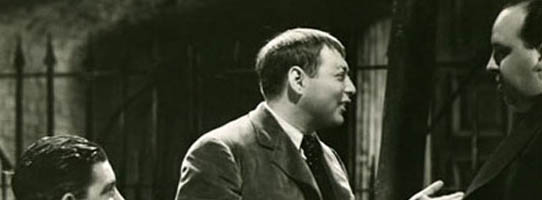
Ever since YouTube lifted their 15-minute length restriction on videos, free full-length versions of classic movies have been popping up all over the site. I’ve watched half a dozen Hitchcock movies in the past few weeks. Here’s one to get you started:
Spellbound (1945): http://www.youtube.com/watch?v=vw0H48BSZ4A
Hi, David Child here. I wanted to do something a bit different with this blog post. Instead of talking about music or art or movies (that’s pretty much been the scope of this band’s blog so far), I wanted to provide a little IKEA Hackers-style How To guide on building the standing desk I use. If you’re not into How To guides, skip this post. I promise the next one will be about MANWOMANCHILD. Anyway, here goes…
The year was 2012 and standing desk fever was sweeping the nation — or at least a small number of articles were written about the benefits of standing and a handful of people who had nothing better to worry about chose to pursue the idea somewhat seriously for a few months before inevitably returning to sitting. My friends, I was one of those people. (And I still am. I’ve actually just made it to the one-year mark and I still do almost all of my recording standing up.)
I looked around for a cheap standing desk, and there were a bunch of options, though nothing that would accommodate all of the stuff in my home studio. Also, all of the standing desks on the market were shockingly expensive. The New York Times had recommended a $4,000 desk. Feeling ambitious, I decided to build my own out of IKEA shelving.
Before you embark on this journey with me, you should be forewarned that the finished product looks like this:
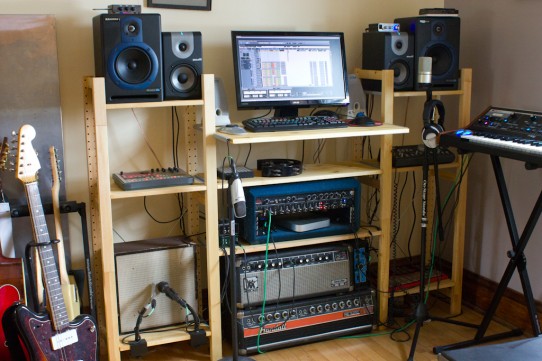
It’s not the most beautiful thing in the world, I know, but I’ve been extremely satisfied with it. It contains all of the studio gear I use (my computer, my speakers, my amps, my 1 x 12″ speaker cabinet, etc.) and, most importantly, it’s exactly the height I wanted. (All of the articles I’ve read say that the shelf should be exactly the height of your elbows.)
So, you ask, how can I own one of these beauties? Well, since you asked, the whole thing is based on the IVAR Shelving System. The specific parts that went into making this are as follows:
I also bought a can of shellac so that I could protect the wood, but that’s really not necessary. Here’s what all of the parts look like on their own:
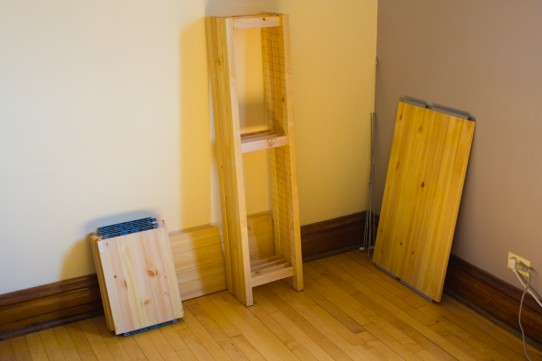
You’ll notice that my big shelf on the right-hand side of the image has two notches cut in it. Those were not there when I bought the parts. We’ll get to those later. I’m not going to go into a huge amount of detail about the basic construction of the shelf, because this part is fairly straightforward. You should know that I put the whole thing together on the floor without the extra-large top shelf. Here’s a photo of that:
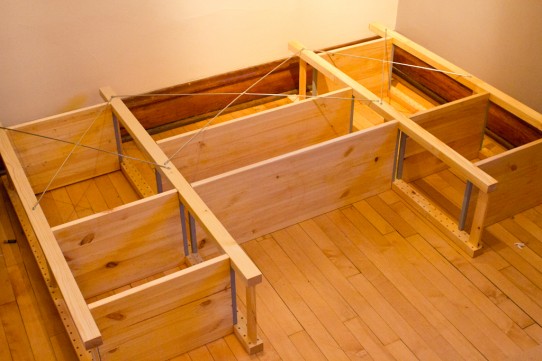
Attaching the 3 metal OBSERVATÖR cross-braces was an odd process. I used a level and a few square-shaped objects to make sure that the whole thing was at right angles. Then, I drilled holes in the side supports and screwed the braces in. The entire shelf (all three parts) are symmetrical but the top hole spots for the middle brace and the side braces don’t line up at all. This is normal. You can see what I mean in the photos that follow. This is the point at which the middle brace meets the side brace at the bottom:
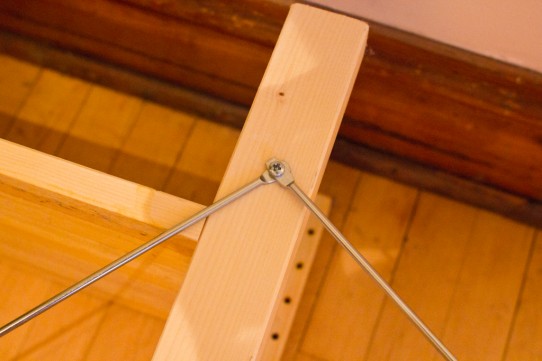
And this is where they meet at the top:
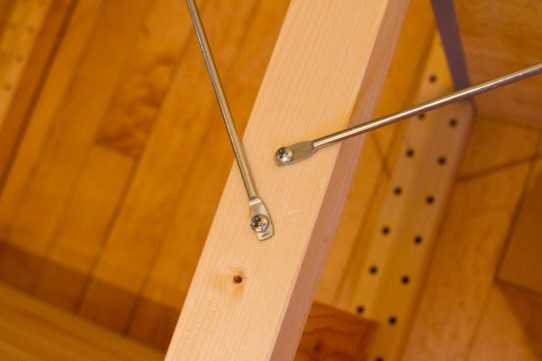
As I said, this is totally normal.
Once I had the whole shelf constructed, I upended it:
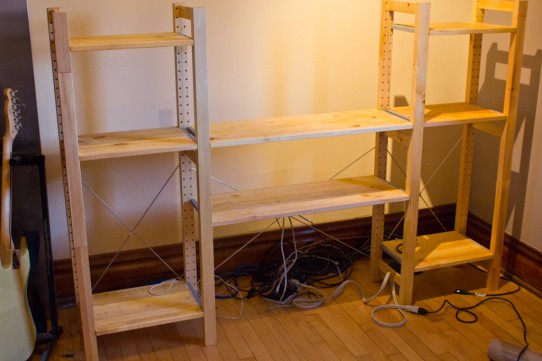
OK. The final step is to attach the large 33“ x 20” shelf, but before we can do this, we need to take a hacksaw (or other implement) and cut notches or rectangular chunks out of the plastic. This is what the notches look like:
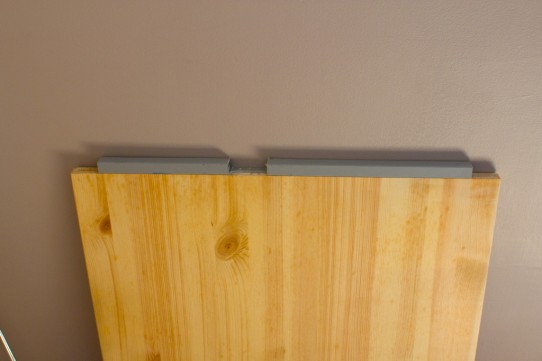
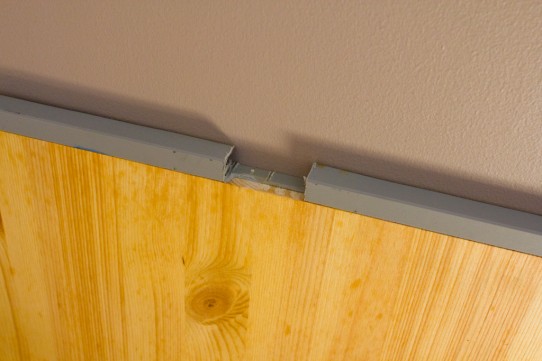
The best way to figure out exactly where the notches should be is to lay the shelf down on the floor next to one of the side-support braces and use the brace as a guide. (“Measure twice, saw once,” or whatever the expression is.)
Once your done, all you have to do is put that top shelf on and celebrate. Note: I actually attached my desk to the wall to keep it from moving while I typed, or from falling over if I applied too much pressure to that top shelf.
OK. That’s it. I hope you enjoyed this project guide.
–David Child
About ten years ago, I was sorting through the marked-down LPs at my favorite record store (Mystery Train in Amherst) when I stumbled on an album by a band I had never heard of called The Perfect Disaster. The album was “Asylum Road” (Fire Records, 1988).
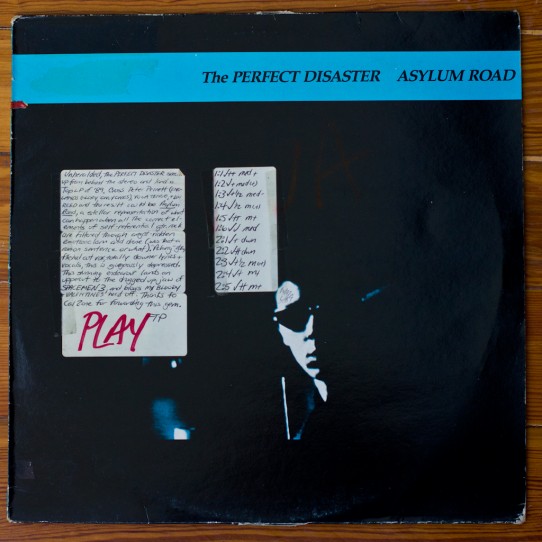
At the time, I had a firm policy of never buying records I wasn’t explicitly looking for, and I probably would have just brushed right past this one if not for a handwritten note taped to it. This particular copy had apparently belonged to WMUA, UMASS Amherst’s radio station, and the student DJ who had listened to it way back in 1989 had scrawled a review on the cover:
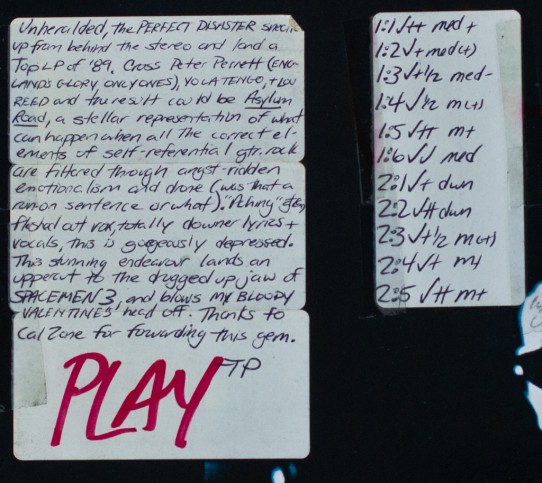
“Unheralded, the PERFECT DISASTER sneak up from behind the stereo and land a Top LP of ’89. Cross Peter Perrett (ENGLAND’S GLORY ONLY ONES), YO LA TENGO, & LOU REED and the result could be Asylum Road, a stellar representation of what can happen when all the correct elements of self-referential gtr. rock are filtered through angst-ridden emotionalism and drone (was that a run-on sentence or what). “Aching” gtr, fleshed out vox, totally downer lyrics + vocals, this is gorgeously depressed. This stunning endeavour [sic] lands an uppercut to the drugged up jaw of SPACEMEN 3, and blows MY BLOODY VALENTINE’S head off. Thanks to Cal Zone for forwarding this gem. PLAY.-TP
I immediately knew I had to buy this record. As weird as this description is (“drugged up jaw”, anyone?), it does a great job of capturing what college radio must have been like back then (i.e. Spacemen 3 were very much on the radar). To boot, the fact that it was handwritten and probably hadn’t been read by anyone since 1989 made me feel like I had received a intimate personal recommendation from a total stranger (a recommendation I’m now passing on to you).
This is a wonderful album—one that I’ve listened to many, many times since that day. If you’re a fan of eighties jangle pop in the vein of the Feelies, Dream Syndicate, and The Go-Betweens, you will love this record. In particular, make sure you listen to TV (Girl On Fire).
It’s shocking to me that this band isn’t better known, particularly given that Josephine Wiggs of the Breeders was their bassist. I looked around and, aside from a great fan page on Facebook, the Perfect Disaster is almost totally unrepresented on the internet. I did find one great blog post from 2010, at the bottom of which none other than Phil Parfitt (lead singer of PD) himself had commented to say that not only is he around, but that he is still writing music (!!!).
I went to the website of their label, Fire Records, but found scarcely any mention of the band. Fire Records itself is alive and kicking. I would *love* to see them issue or reissue the Perfect Disaster catalog in MP3 format. In the meantime, I’ve digitized the Perfect Disaster’s “Asylum Road.” You can listen to it here:
You can download it here. You can buy it used on vinyl here.
Needless to say, this is copyrighted material which I’m sure belongs to Fire Records. I’m providing this to the internet in the hopes that someone will hear this and realize what a great, overlooked band this was. At the first whiff of a copyright complaint I will, of course, take this down.
—Dave
I went for a walk down Broadway yesterday.